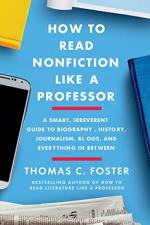
|
| Name: _________________________ | Period: ___________________ |
This test consists of 15 multiple choice questions and 5 short answer questions.
Multiple Choice Questions
1. In Chapter 12, "Life from the Inside," Foster says that an author of a history about long-ago events is not really so much a reporter as a what?
(a) Artist.
(b) Compiler.
(c) Poet.
(d) Critic.
2. In Chapter 13, "On the Stump," what does Foster say that Wolff mostly wrote about before writing Fire and Fury?
(a) Travel.
(b) Celebrities.
(c) History.
(d) Food.
3. In Chapter 10, "From the Inside Out," what aspect of Renaissance scholarship does Foster say the essay rebels against?
(a) The veneration of classical Greece and Rome.
(b) Respect for accurate history.
(c) The importance of institutional authority.
(d) Obedience to the Christian God.
4. In Chapter 11, "Life from the Inside," what does Foster call the "most famous" African American autobiography (171)?
(a) The Autobiography of Malcolm X.
(b) Dreams from My Father.
(c) Between the World and Me.
(d) Narrative of the Life of Frederick Douglass.
5. Based on Chapter 14, "The Universe of Ideas/Ideas of the Universe," what would Foster call a journalist writing a general survey of the field of string theory?
(a) Journalistic compilation.
(b) Expert testimony.
(c) Interrogation of text.
(d) Amateur profiles.
6. In Chapter 12, "Life from the Inside," what does Foster suggest that Ambrose loses by choosing to focus on Lewis?
(a) The chance to engage a wider audience of readers.
(b) Information about what happened after Lewis's death.
(c) A variety of perspectives.
(d) The reader's trust.
7. In Chapter 9, "Living the News," how does Foster apply the idea of "free indirect speech" to New Journalism?
(a) He uses it to compare New Journalism with immersive journalism.
(b) He uses it to contrast New Journalism with fiction.
(c) He uses it to label Wolfe's attempt to recreate the inner lives of his subjects.
(d) He uses it to explain how Thompson narrates his own thoughts.
8. In Chapter 9, "Living the News," Foster calls Fear and Loathing a roman à clef. What is he saying about this book?
(a) It is a book of nonfiction thinly disguised as fiction.
(b) It is a work that translates a novel in another language into English.
(c) It is a work of fiction that parodies a work of journalism.
(d) It is an autobiographical book about journalism.
9. In "Interrogating the Text," Foster says that source material should be "apt." He means that source material should be what?
(a) Logically related to the arguments being advanced.
(b) Clearly attributed.
(c) Contextualized through editorial comments.
(d) Authoritative.
10. In Chapter 13, "On the Stump," which work does Foster say that Comey's book A Higher Loyalty is similar to?
(a) All the President's Men.
(b) Apologia Pro Vita Sua.
(c) The Electric Kool-Aid Acid Test.
(d) Fear and Loathing in Las Vegas.
11. In "Interrogating the Text," Foster says that he himself tends to "eschew" notes. He is saying what about his use of notes?
(a) His notes are sometimes disorganized.
(b) He does not use them.
(c) He tends to provide too many.
(d) He backs up his notes with a Works Cited section.
12. In Chapter 9, "Living the News," which author does Foster say is at the opposite "pole" of New Journalism from Hunter S. Thompson?
(a) Tom Wolfe.
(b) Joan Didion.
(c) Truman Capote.
(d) Raoul Duke.
13. In "Interrogating the Text," Foster says that readers should beware of ad hominem arguments. What he means is that readers should be suspicious when writers do what?
(a) Contend that because something is new it must be better or more correct.
(b) Portray the opposition argument as much weaker than it actually is.
(c) Attack the people making arguments instead of the arguments themselves.
(d) Appeal to emotion rather than to logic.
14. In Chapter 15, "Reading Internet Sources," Foster cites Wikipedia as the source of his information about the development of the internet. What might we reasonably call his use of Wikipedia as a source?
(a) Ironic.
(b) Engaging.
(c) Scholarly.
(d) Careless.
15. In Chapter 10, "From the Inside Out," which writer does Foster credit with originating the essay?
(a) Virginia Woolf.
(b) Rene Descartes.
(c) George Orwell.
(d) Michel de Montaigne.
Short Answer Questions
1. In Chapter 9, "Living the News," which work does Foster say is likely the first example of New Journalism?
2. In Chapter 10, "From the Inside Out," what type of nonfiction writing does Foster refer to as "soggy" (141), and "soul-deadening" (142)?
3. According to Foster in Chapter 9, "Living the News," what is McPhee's purpose in comparing geological change over time to a road trip?
4. In Chapter 13, "On the Stump," Foster says that a look at social media reveals what about Americans of all political persuasions?
5. In Chapter 14, "The Universe of Ideas/Ideas of the Universe," what does Foster say is true about contemporary America?
|
This section contains 846 words (approx. 3 pages at 300 words per page) |

|




